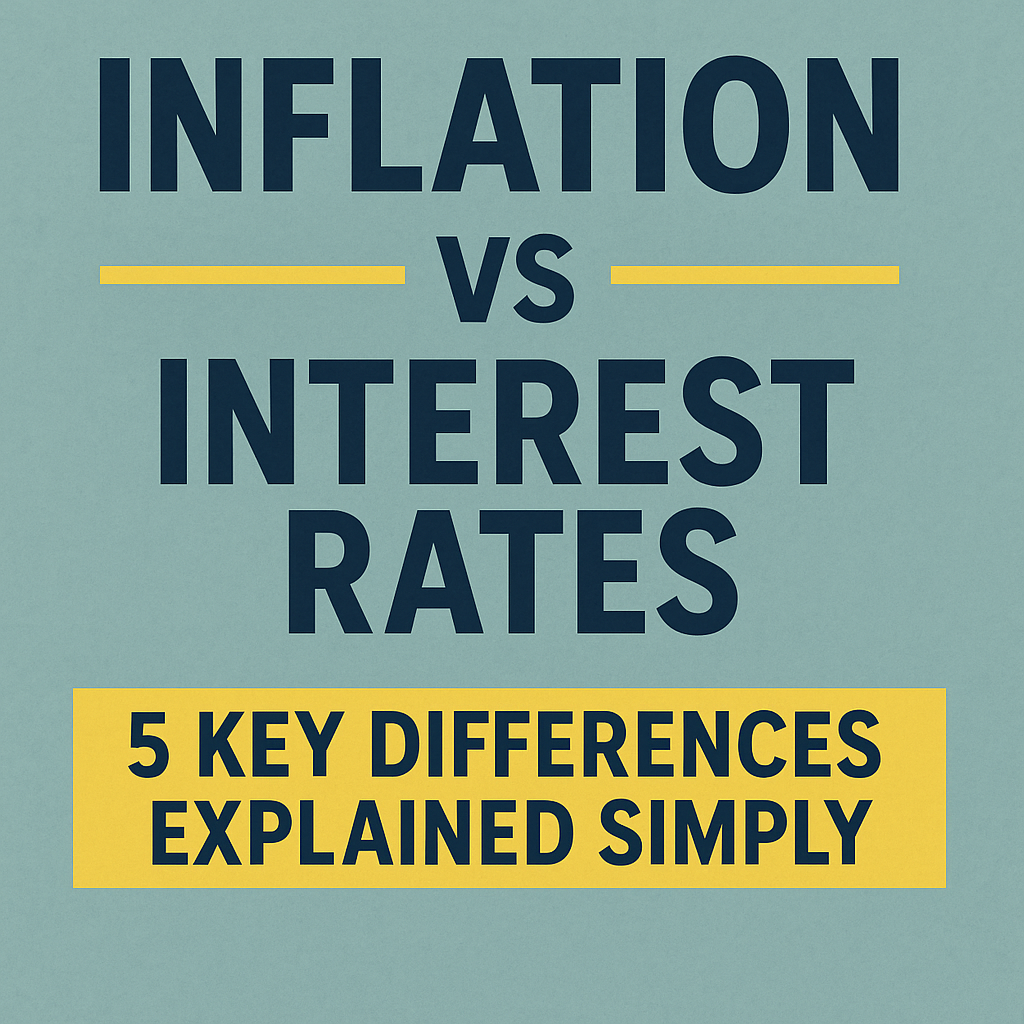Inflation and interest rates are two of the most talked-about terms in the news — but what do they really mean, and how do they affect you? Whether it’s the price of milk rising or your savings earning less than you hoped, both inflation and interest rates play a central role in shaping your financial life.
In this article, we’ll break down the key differences between inflation and interest rates, how they interact, and why they matter to everyday people. We’ll walk through five core concepts using relatable examples to make it all clear.
Let’s explore Inflation vs Interest Rate and how this dynamic impacts your pocket.
Table of Contents

What Is Inflation?
Inflation is what happens when the general cost of living rises. In other words, the money in your pocket doesn’t stretch as far as it used to. If a pint of milk cost £1 last year and £1.10 this year, that’s inflation in action — a 10% increase.
In the UK, inflation is usually measured using the Consumer Price Index (CPI), which tracks the prices of a ‘basket’ of everyday goods and services like food, clothing, and energy bills. A little inflation (around 2%) is considered normal and even healthy. Too much, however, can lead to financial strain as wages and benefits may not keep up.
What Are Interest Rates?
Interest rates are the cost of borrowing money or the reward for saving it. They’re usually shown as a percentage. If you borrow £1,000 on a credit card with a 10% interest rate, you’ll owe £100 in interest over the year (if you don’t repay).
In the UK, the Bank of England sets the official base rate, which influences the interest rates offered by banks and lenders. Higher rates make loans and mortgages more expensive, but savings accounts more rewarding.
Think of interest rates as the brakes or accelerator of the economy — used to either cool things down or speed them up.
Inflation vs Interest Rate – 5 Key Differences
Let’s look at five major ways these two forces differ — and how they affect your finances.
1. Cause vs Tool
- Inflation is an economic outcome — prices go up over time due to demand, supply issues, or external shocks (like energy prices).
- Interest rates are a policy tool — the Bank of England changes them to influence inflation.
Analogy: Inflation is like rising heat in a room. Interest rates are the thermostat used to cool things down.
2. Effect on Spending Power
- Inflation reduces your spending power — your money buys less.
- Higher interest rates encourage saving and discourage borrowing — slowing down consumer spending.
Example: Rising prices mean your weekly shop now costs £80 instead of £70. At the same time, higher loan rates mean your credit card bill becomes more expensive.
3. Winners and Losers
- Inflation can help debtors — because the real value of what they owe shrinks.
- Interest rate hikes help savers — by increasing the returns on savings accounts and ISAs.
Example: If you have a fixed-rate mortgage, inflation erodes the real value of your repayments. But if you’re trying to save for a house deposit, high inflation with low savings rates hurts.
4. Savings vs Borrowing
- With inflation rising but interest rates staying low, your savings lose value in real terms.
- When interest rates rise, borrowing costs go up — but so can your returns on savings.
Example: You’re earning 2% on your savings, but inflation is 5% — your money is effectively shrinking by 3% each year.
5. How the Government Responds
- Central banks raise interest rates to reduce inflation by slowing demand.
- This process is part of monetary policy — the strategy used to manage the economy.
Example: In 2023, the Bank of England raised rates multiple times to combat high post-pandemic inflation.
How Inflation and Interest Rates Interact
Inflation and interest rates are closely connected. When inflation rises too quickly, the Bank of England usually raises interest rates. This encourages people to save rather than spend and makes borrowing more expensive — which helps reduce inflation over time.
Cycle Analogy: Think of the economy like a car going downhill. Inflation is the increasing speed — interest rate rises are the brakes to slow it down.
The opposite can also happen. If inflation is too low or the economy is shrinking, the Bank may cut rates to stimulate spending and investment.
Why This Matters to You
Understanding Inflation vs Interest Rate isn’t just for economists. These forces affect your:
- Mortgage payments — higher rates mean more expensive monthly repayments.
- Savings growth — inflation can outpace your savings, reducing their real value.
- Wages and benefits — if they don’t keep up with inflation, your lifestyle suffers.
- Everyday spending — from groceries to energy bills, rising prices affect your budget.
Knowing how these two forces interact can help you make better financial decisions — from locking in a fixed-rate mortgage to choosing the right savings account.
Frequently Asked Questions (FAQ)
Is inflation always bad?
A little inflation is normal and even healthy — it encourages spending and investment. It only becomes a problem when it rises too quickly or unpredictably.
Why does the Bank of England raise interest rates?
To control high inflation by making borrowing more expensive and slowing down demand in the economy.
How do interest rates affect house prices?
Higher interest rates make mortgages more expensive, which can reduce demand for homes and slow price growth.
Should I save more when interest rates are high?
Yes — higher interest rates mean better returns on savings accounts and ISAs. But inflation can still eat into real returns.
What’s the current inflation rate in the UK?
You can check the latest figure from the Office for National Statistics (ONS) or financial news websites. The Consumer Price Index (CPI) is the most common measure.
Conclusion
Inflation and interest rates are like two sides of the same economic coin — they push and pull each other and affect nearly every part of your financial life. From the cost of your coffee to your retirement savings, their impact is real.
By understanding the five key differences we’ve covered — and how they interact — you’ll be better equipped to navigate your finances.
Keep an eye on the economy, and you’ll spot the signs: when inflation rises, interest rate changes usually follow. And now, you’ll know exactly why.
Explore more in our glossary: CPI, Base Rate, Savings Account, Mortgage.
